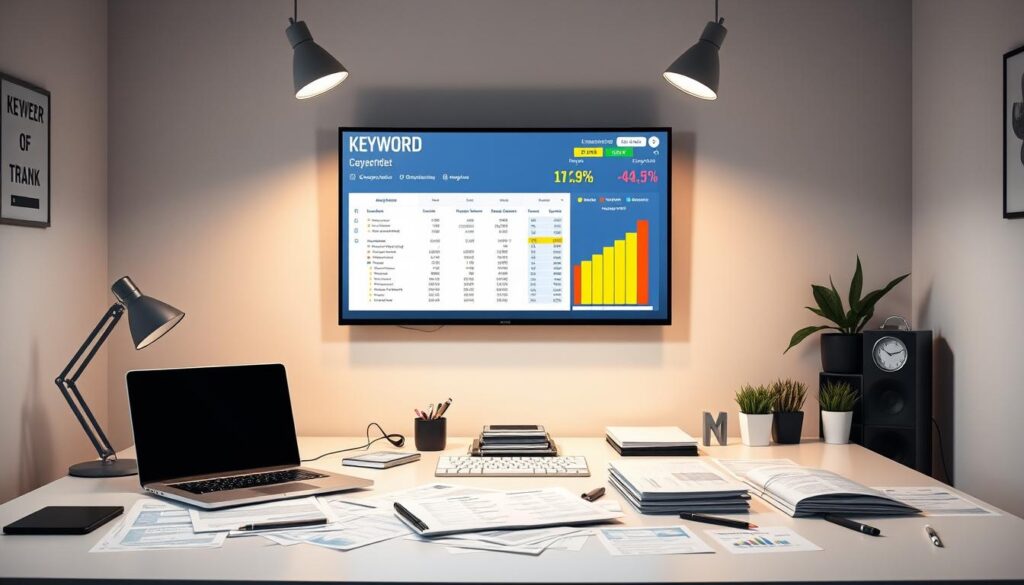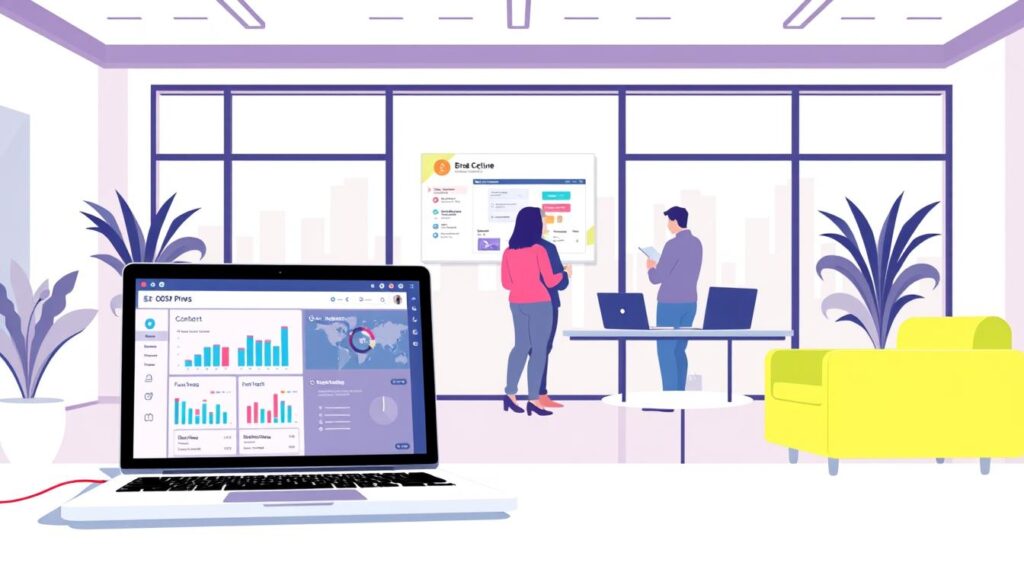In today’s digital world, a strong content funnel is key for SaaS success. Eli Schwartz, in Product-led SEO: The Why Behind Building Your Organic Growth Strategy, says sustainable SEO is more than ranking high. It’s about guiding your product to grow.
We’ll show how to use product-led SEO to draw in more customers. By knowing your product’s growth and making buyer personas, you can make content that speaks to your audience.
Key Takeaways
- Understand the importance of product-led growth for your SaaS.
- Learn how to create effective buyer personas.
- Discover the secrets to crafting high-quality, engaging content.
- Find out how to leverage SEO for sustainable growth.
- Understand how to build a complete content funnel.
Understanding Product-Led Growth in SaaS
In the fast-changing world of SaaS, product-led growth is a key strategy. It uses the product to get, keep, and grow customers.
With product-led growth, SaaS companies can make their sales process better. This method depends on the product’s value to attract and keep customers. It doesn’t just rely on sales and marketing.
What is Product-Led Growth?
Product-led growth (PLG) puts the product first in the customer’s journey. It makes a product so valuable and easy to use that it sells itself. This means a smooth onboarding, an easy-to-use interface, and updates based on what customers say.
PLG is not just about getting new customers. It’s also about keeping them and growing the relationship. By giving value through the product, SaaS companies can build loyalty and grow over time.
Benefits of a Product-Led Approach
Using a product-led approach has many benefits, including:
- Increased customer satisfaction: Delivering value through the product improves satisfaction and lowers churn.
- Improved customer acquisition: A product-led approach attracts new customers through word-of-mouth and positive reviews.
- Enhanced retention: Making the product better keeps customers longer.
- Data-driven decision making: PLG uses data and customer feedback to guide product development and business decisions.
Key Metrics to Monitor
To see if a product-led growth strategy works, SaaS companies should watch these key metrics:
- Activation rate: The percentage of users who start using the product after onboarding.
- Retention rate: The percentage of customers kept over time.
- Expansion revenue: Money made from existing customers through upselling or cross-selling.
- Customer lifetime value (CLV): The total value a customer brings to the business over their lifetime.
By focusing on these metrics, SaaS companies can improve their product-led growth strategy and keep getting better.
The Role of SEO in Product-Led Growth
SEO is key in product-led growth, helping to find and attract users. In the SaaS world, a strong SEO plan is vital for success.
By making our product and content search-friendly, we boost our online presence. This leads to more qualified leads and higher conversions. Product-led SEO helps us focus our SEO efforts on our product’s needs.
How SEO Influences User Acquisition
SEO makes our product easier to find online. By using the right keywords and creating valuable content, we draw in users looking for our solutions.
This increases website traffic and the chance of turning visitors into customers. A well-optimized site also builds trust, making our user acquisition efforts more effective.
SEO’s Impact on Product Discovery
SEO affects how people find our product in many ways. By optimizing our pages and content, we make our product more visible in search results.
In the SaaS world, users often search for specific solutions. By showing up in these searches, we can offer our product as a solution. This brings in more qualified leads and boosts our revenue.
Creating Buyer Personas for SEO
Creating buyer personas is key to making our SaaS content funnel meet our customers’ needs. We learn who our ideal customers are to make content that speaks to them. This guides them through the buyer’s journey.
Identifying Our Target Audience
To make effective buyer personas, we first identify our target audience. We look at demographics, job roles, and their challenges. Our goal is to create content that addresses their specific pain points, making our SaaS solution appealing and relevant.
We use data from customer feedback, social media, and market research to understand our audience. This data-driven approach helps us tailor our content strategy to engage with our target audience effectively.
| Demographic | Characteristics | Preferred Content |
|---|---|---|
| Marketing Professionals | Age 25-45, interested in digital marketing trends | Blog posts, webinars on SEO and content marketing |
| IT Managers | Age 30-55, focused on technology solutions | Case studies, whitepapers on SaaS integration |
| Business Owners | Age 25-60, concerned with business growth | E-books, videos on business strategy and growth hacking |
Analyzing Buyer Journey Stages
Understanding the buyer’s journey is key to creating relevant content at each stage. The journey includes awareness, consideration, and decision stages. By analyzing these stages, we can develop content that nurtures leads and guides them towards making a purchase.
At the awareness stage, we create informative blog posts and guides that address initial questions and concerns. As they move to the consideration stage, we offer detailed content like case studies and comparison guides. At the decision stage, we provide testimonials and demos to help seal the deal.
By creating buyer personas and understanding the buyer journey stages, we can optimize our SEO efforts. This approach ensures our content is not only visible but also relevant and valuable to our target audience.
Keyword Research for SaaS Websites
In the world of SaaS, keyword research is key for SEO success. It helps us understand what our customers are looking for. This way, we can make our content better, boosting our search engine ranking.

Tools for Effective Keyword Research
We use special tools for keyword research. Ahrefs, SEMrush, and Moz Keyword Explorer are top choices. They help us find the right keywords, see what competitors do, and track how keywords perform.
These tools reveal long-tail keywords with less competition and better conversion rates. Instead of just “project management,” we might aim for “project management tools for remote teams.”
Long-Tail vs. Short-Tail Keywords
The choice between long-tail and short-tail keywords matters a lot in SaaS SEO. Short-tail keywords are broad and generic, but they have more competition. Long-tail keywords are specific, less competitive, and attract more qualified leads.
“Cloud storage” is a short-tail keyword, while “secure cloud storage for businesses” is a long-tail one. We focus on long-tail keywords to meet specific customer needs.
Competitor Analysis
Looking at our competitors’ keyword strategies is also important. By seeing what keywords they rank for, we find gaps in our strategy. This helps us find ways to beat them.
Tools like Ahrefs and SEMrush let us check our competitors’ websites. We can see their top keywords and even their backlinks. This info is key to improving our SEO and staying competitive in the SaaS world.
Crafting High-Quality Content
Creating a strong content funnel needs a deep understanding of what makes content valuable. High-quality content is key to attracting and keeping customers. It drives the success of our SaaS product-led growth strategy.
Importance of Valuable Content
Valuable content is the heart of any good content marketing strategy. It draws in and guides customers through their journey. By sharing valuable insights and solutions, we become leaders in the SaaS world.
The value of content is in how it connects with our audience. It tackles their problems and interests. This connection builds trust and loyalty among our customers.
Types of Content to Create
To build a full content funnel, we must create various content types. These include:
- Blog posts with industry insights and tips
- In-depth guides and eBooks with detailed info
- Case studies and success stories showing our product’s impact
- Webinars and videos to engage our audience in different ways
By mixing our content, we meet different learning styles and buyer stages.
Balancing Technical and Educational Content
Finding the right mix of technical and educational content is key. Technical content shows our expertise, while educational content informs and empowers.
To get this balance, we should:
- Spot the technical parts of our product that need explaining
- Make educational content for common questions and problems
- Use both technical and educational content for different audience parts
Building a Content Marketing Strategy
To make the most of product-led growth, SaaS companies need a solid content marketing plan. This means knowing our audience, making content they’ll find useful, and sharing it well.
Aligning Content with Customer Needs
It’s key to match our content with what our customers need. We do this by knowing what problems they face and what they’re interested in. This way, our content speaks to them, boosting engagement and sales.
To align content well, we should:
- Do deep research on our audience
- Create detailed buyer personas
- Match content with the buyer’s journey stages
Setting Clear Goals and KPIs
Having clear goals and KPIs is vital to see if our content strategy works. We need to know what we aim to achieve, like more website visitors, leads, or sales.
Our KPIs should be specific, measurable, achievable, relevant, and timely (SMART). For example:
- Increase organic traffic by 20% in 6 months
- Boost lead generation by 15% in a year
- Improve customer engagement by 30% with targeted content
Distribution Channels for Content
Picking the best places to share our content is important. We should find out where our audience hangs out and focus there.
Some great places to share include:
- Social media (LinkedIn, Twitter, Facebook)
- Email newsletters
- Industry forums and communities
- Guest posts on relevant websites
By matching our content to what customers need, setting clear goals, and using the right channels, we can build a strong content marketing plan. This plan will boost our product-led SEO and help our SEO PLG SaaS goals.
Optimizing On-Page SEO
Optimizing on-page SEO is key for SaaS companies. Focus on title tags, meta descriptions, header tags, and internal linking. This boosts our product’s visibility.
Importance of Title Tags and Meta Descriptions
Title tags and meta descriptions are vital for on-page SEO. They give search engines important info about our content. This helps them see how relevant and contextual it is.
- Title Tags: They should be short, descriptive, and include our target keywords. A good title tag can increase clicks and rankings.
- Meta Descriptions: They summarize our content and should make users want to click. Including keywords helps with search visibility.
Utilizing Header Tags Effectively
Header tags (H1, H2, H3, etc.) are key for organizing our content. They highlight important points. Using them well improves our content’s readability and SEO.
- Use H1 tags for main headings and make sure they have our target keywords.
- Use H2 and H3 tags for subheadings and to break up content.
- Keep a logical structure by organizing header tags in a hierarchical order.
Internal Linking Strategies
Internal linking is a strong SEO tactic. It helps search engines understand our content’s structure and improves user experience. By linking to relevant pages, we boost our content’s visibility and drive traffic.
- Link to Relevant Content: Make sure internal links are relevant and useful to the user.
- Use Descriptive Anchor Text: Use clear anchor text for internal links to help search engines understand the context.
- Avoid Over-Linking: Don’t overdo it with links, as too many can harm user experience.
Leveraging Technical SEO for SaaS
Technical SEO is key in our SaaS product-led SEO strategy. It helps us rank better in search engines. This leads to more qualified leads and better visibility for our product.
Ensuring a Mobile-Friendly Experience
In today’s world, having a mobile-friendly website is essential. Most users access our SaaS product on mobile devices. We need to make sure our website works well on all devices.
A mobile-friendly design improves user experience and search rankings. Search engines like Google favor mobile-friendly sites. To achieve this, we focus on responsive design, fast loading, and easy navigation.

Site Speed Optimization Techniques
Site speed is vital for user experience and search rankings. A slow site can cause users to leave quickly. This hurts engagement and conversion rates.
To speed up our site, we use image compression, CSS and JavaScript minification, and browser caching. We also use content delivery networks (CDNs). Tools like Google PageSpeed Insights help us find and fix issues.
Indexing and Crawlability Issues
Indexing and crawlability are critical for search engine visibility. If our site isn’t indexed, our content won’t show up in search results. This reduces visibility and traffic.
To fix these issues, we create a clear site structure. We use robots.txt and meta tags wisely. And we submit a sitemap to search engines. This ensures our SaaS product is easy to find by our target audience.
The Power of User-Generated Content
User-generated content is key in SEO for product-led growth. It makes our SaaS content more real and engaging. This helps attract more customers.
User-generated content builds trust and attracts new customers. It shows our product’s quality and effectiveness. This helps others make informed choices.
Encouraging Reviews and Testimonials
Encouraging reviews and testimonials is a great way to use user-generated content. They prove our product’s value and show its impact on users.
To get more reviews, we can make the process easy. We can offer rewards for feedback. And, we should always respond to all reviews. This shows we value our users’ opinions and builds a community.
Utilizing Customer Case Studies
Customer case studies are also powerful. They tell stories of how our product helped others achieve their goals. This makes our product more appealing to others.
To make great case studies, we need to find successful users. We should interview them and share their challenges, solutions, and results. This shows our product’s real-world benefits.
Using user-generated content in our SaaS content funnel boosts our SEO. It builds trust with customers and drives more sales. It’s a win-win for our marketing and our users.
Social Proof and Its Importance
Social proof is key in our product-led SEO strategy. It helps build trust with our audience. In the SaaS world, where competition is high, trust is essential.
Showing off our current clients’ success stories is a great way to use social proof. By sharing their achievements and the benefits they got from our product, we create a story that speaks to others.
Building Trust with Client Logos
Using client logos is a simple yet effective way to show social proof. It proves our product’s credibility and trustworthiness. When people see big brands using our product, they’re more likely to think about it for themselves.
- Select logos from a variety of industries to showcase versatility
- Use high-quality images that are easily recognizable
- Provide context by including a brief description of the client’s experience with our product
Showcasing Case Studies and Success Stories
Case studies and success stories give a closer look at how our product has helped clients. By sharing specific challenges, solutions, and results, we show the real value of our product.
| Client | Challenge | Solution | Outcome |
|---|---|---|---|
| Company A | Increased user engagement | Implemented our analytics tool | 25% increase in engagement |
| Company B | Streamlined operations | Integrated our project management feature | 30% reduction in project timelines |
By using social proof through client logos, case studies, and success stories, we boost our product-led SEO. This helps attract more customers to our SaaS product.
Measuring SEO Success
Understanding the impact of our product-led content funnel is key. We track important metrics and use the right tools. This helps us improve our SEO strategy to meet our SaaS goals.
Key Performance Indicators to Track
To gauge SEO success, we focus on specific metrics. These metrics show how well our strategy works. Here are a few:
- Organic traffic growth: An increase in organic traffic shows our SEO efforts are effective.
- Keyword rankings: Tracking our rankings for target keywords helps us see our search visibility.
- Conversion rates: Measuring the percentage of visitors who take a desired action shows our SEO’s impact on engagement.
By tracking these KPIs, we get a full picture of our SEO performance. We can then spot areas for betterment.
Tools for Monitoring SEO Performance
Many tools help us keep an eye on our SEO performance. Some top ones are:
- Google Analytics: Gives us insights into website traffic, engagement, and conversion rates.
- SEMrush: Offers technical SEO audits, keyword tracking, and competitor analysis.
- Ahrefs: Helps us monitor backlinks, track keyword rankings, and analyze content performance.
With these tools, we can collect valuable data. This data informs our SEO strategy and drives improvement.
By using the right KPIs and tools, we can measure SEO success well. This way, we make informed decisions to boost our product-led content funnel.
Continuous Content Improvement
Improving content is key for a successful product-led SEO strategy. We keep our content fresh and engaging. This helps attract and keep our target audience interested.

We create a content funnel to guide buyers. This funnel is vital for staying ahead in the SaaS world. Regular updates are essential.
Analyzing Content Performance
To better our content, we first check its performance. We look at page views, engagement, and conversion rates. This helps us see where we can do better.
Google Analytics gives us deep insights. It shows us which content works and what needs work.
- Track page views and engagement metrics.
- Analyze conversion rates to understand content effectiveness.
- Use tools like Google Analytics for insights.
Updating and Refreshing Existing Content
After analyzing, we update our content. This might mean rewriting old parts, adding new info, or boosting SEO.
Keeping our content current helps it show up better in search results. It also keeps it relevant to our audience.
Key strategies include:
- Rewriting outdated content to reflect current trends and information.
- Enhancing SEO elements for better search engine ranking.
- Adding new insights or data to existing content.
By using these strategies, our content stays valuable. It supports our product-led SEO goals well.
Using Data to Drive Content Decisions
In today’s digital world, using data to guide content choices is key for SaaS companies. It helps them grow their product-led strategies. By using data, we can make content that our audience loves and helps our business grow.
A/B Testing Content Formats
A/B testing helps us find the best content formats for our audience. We compare different content types to see which ones get the most engagement and sales.
- Test different content types, such as videos, blog posts, and infographics.
- Analyze engagement metrics to determine which formats perform best.
- Use the insights gained to inform future content creation.
Leveraging Analytics for Insights
Analytics tools give us lots of info on how our content does. By using these insights, we can make our content strategy better for our audience.
Key analytics metrics to track:
- Page views and unique visitors.
- Bounce rates and time on page.
- Conversion rates and goal completions.
By mixing A/B testing with analytics, we can build a strong content strategy. This approach helps us keep improving our content. It makes sure it stays relevant and effective in growing our SaaS business.
SEO and Product Feature Launches
In the competitive SaaS world, launching new features with a solid SEO plan is key. As we grow and add more to our product, making our content SEO-friendly is vital. This is a big part of our product-led SEO strategy.

Optimizing Content for New Features
When we introduce new features, we must make our content shine. We do this by finding the right keywords our audience uses. This helps us rank better in search results and attract more quality leads.
We also create detailed content that meets our users’ needs. This could be guides, tutorials, or FAQs. They show off our new features and offer real value. This boosts our product’s visibility and makes us leaders in the SaaS field.
Timing Our Launch Content Strategically
The timing of our content is as critical as its quality. We plan our content releases carefully to make the biggest splash. This means aligning our content calendar with our product roadmap.
Using SEO PLG SaaS tactics, we make sure our content hits the mark. We study our competitors, understand what our audience searches for, and tweak our strategy as needed.
In summary, blending SEO into our feature launches is a complex task. It involves optimizing content, timing its release, and adjusting our strategy based on results. This way, we boost our product’s visibility, increase conversions, and stay ahead in the SaaS market.
Creating a Community Around Our Product
Building a community around our SaaS product is key for loyalty and growth. We create a space for users to interact, share, and support each other. This boosts their experience with our product.
Building Loyalty Through Engagement
Engagement is vital for a loyal community. We use strategies to get users involved. This includes creating fun content, hosting webinars, and using social media for talks.
By making users feel part of something, we grow their loyalty. Loyal customers stick with us, share our service, and give feedback to help us get better.
Using Forums and Social Media
Forums and social media are great for community building. We connect with users on platforms they love.
- Create forums for users to talk about our product, share tips, and ask questions.
- Share updates, behind-the-scenes stuff, and user content on social media.
- Keep an eye on feedback and respond to show we care about our community.
Using these channels well, we build a lively community. It supports our growth and boosts our SEO with user content.
Future Trends in SaaS SEO
As we move forward in the SaaS world, it’s key to stay ahead. This helps us create a better SEO strategy. By knowing the future trends in SaaS SEO, we can make our product-led SEO better. This will help us grow and get more users.
Voice Search Optimization
Voice search is changing how people use our products. We need to make our content work for voice search. This means using natural language and long-tail keywords to show up in search results.
The Importance of Video SEO
Video is getting more important in SaaS marketing. Using video SEO, we can make our product demos, tutorials, and testimonials better. This makes our content more engaging and reaches more people. It’s key for SEO PLG SaaS companies to stand out.
By adopting these trends and adding them to our SEO strategy, we can boost our online presence. This leads to more qualified leads and fuels our SaaS growth.
FAQ
What is product-led growth, and how does it relate to SEO?
Product-led growth focuses on using the product to get more customers. It’s about keeping them and growing the business. By understanding this, SaaS companies can make their SEO better. This attracts more people to their product.
How does SEO influence user acquisition in SaaS?
SEO is key in getting more users for SaaS products. It makes the product more visible online. This helps attract more customers.
What is the importance of creating buyer personas in SEO?
Knowing who your audience is is very important. By understanding their needs, you can make content that meets those needs. This helps your SEO.
How do we conduct keyword research for our SaaS website?
Finding the right keywords is a must. Tools like Ahrefs and SEMrush help find what people are searching for. This makes your SEO better.
What types of content should we create for our SaaS product?
Making great content is important. You should write blog posts, case studies, and whitepapers. These help meet your audience’s needs.
How do we optimize our content for search engines?
Making your content easy for search engines to find is key. Use title tags, meta descriptions, and header tags. Also, link to other pages on your site.
What is the role of technical SEO in SaaS?
Technical SEO is very important. Make sure your site works well on mobile devices. Also, speed up your site and fix any issues that might stop search engines from indexing it.
How can we leverage user-generated content for our SaaS product?
Using content from your users is powerful. Encourage reviews and testimonials. Use customer stories to show success and attract more customers.
What is the importance of social proof in SaaS?
Social proof is very important. It builds trust. Use client logos and success stories to show your product’s value.
How do we measure the success of our SEO strategy?
It’s important to know if your SEO is working. Look at organic traffic, keyword rankings, and conversion rates. This tells you if your strategy is effective.
What are the future trends in SaaS SEO that we should be aware of?
Keep an eye on voice search and video SEO. These are new trends that can help your SEO strategy stay ahead.
